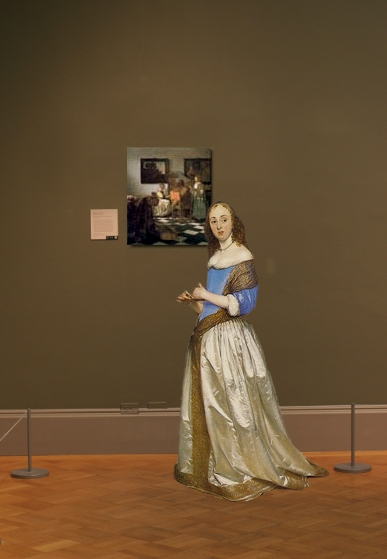The Concert
(Het concert)c. 1663–1666
Oil on canvas
72.5 x 64.7 cm. (28 1/2 x 25 1/2 in.)
Isabella Stewart Gardner Museum, Boston
inv. P21W27

The textual material contained in the Essential Vermeer Interactive Catalogue would fill a hefty-sized book, and is enhanced by more than 1,000 corollary images. In order to use the catalogue most advantageously:
1. Scroll your mouse over the painting to a point of particular interest. Relative information and images will slide into the box located to the right of the painting. To fix and scroll the slide-in information, single click on area of interest. To release the slide-in information, single-click the "dismiss" buttton and continue exploring.
2. To access Special Topics and Fact Sheet information and accessory images, single-click any list item. To release slide-in information, click on any list item and continue exploring.
The painting in the background of a bordello scene
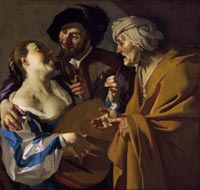
The Procuress
1622
102 x 108 cm.
Museum of Fine Arts, Boston
This picture, The Procuress by Dirck van Baburen, most likely belonged to Vermeer's mother-in-law, Maria Thins. She had patrician connections in Delft and a discreet art collection of the Utrecht Caravaggists. The painting portrays a young female lutenist, a bearded man as the client and an older woman, the procuress, pointing to her open hand soliciting payment. Although these ribald low-life subjects had waned in popularity by the late 17th century, Vermeer seems to have valued them. He saw them not only as a method to introduce commentary on scenes depicted in his own works but also admired Van Baburen's bold technique and technical prowess.
Given the composition of the Van Baburen trio mirroring the "merry company" below, early critics speculated that the true subject of Vermeer's Concert might be an upscale brothel. In this interpretation, the older singing woman to the right becomes the procuress, the seated lutenist the client and the seated harpsichordist the prostitute. Modern critics, considering the calm ambiance of Vermeer's work, view Van Baburen's piece more as a caution against sensual indulgence than an endorsement of it.
The Arcadian landscape above the harpsichordist
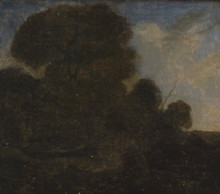
No other painting exemplifies the challenges of interpreting the symbolic content in Vermeer's works as well as this one.
Art historian Elise Goodman suggests that the rugged Arcadian landscape above the harpsichordist's head relates solely to her. In Vermeer's time, composers frequently contrasted bleak landscapes with the gentle beauty of their female subjects. The woman may be linked to the landscape, aligning with the universal convention where the woman is seen as the epitome of nature, metaphorically portrayed as the Tree of Life. The idea that the woman was the "masterpiece of nature" resonates in countless songs, poems and writings about beautiful women from the 17th century.
On the other hand, positing that the "rugged" landscape (painted in the style of Jacob van Ruisdael) acts as a contrast to the serene scene of the three musicians, Arthur K. Wheelock Jr. draws attention to its feature of a dead tree trunk. This is a motif Ruisdael frequently employed to signify death and decay.
Perhaps Vermeer, distinct from some genre painters who approached similar themes with more direct clarity, opted for ambiguity over definitiveness. This method offers viewers a wider range of interpretations and a deeper personal connection to the piece.
The harpsichord

The harpsichord featured in Vermeer's painting, adorned with a lush landscape on its lid, was almost certainly crafted by the esteemed Ruckers family in Antwerp. Such an instrument would have been present only in the parlors of the affluent. Thus, even though the artist resided with his prosperous mother-in-law, Maria Thins, the depiction is likely based on a real instrument lent to the artist for the painting. Moreover, it is the only harpsichord that appears in Vermeer's oeuvre. The other keyboard instruments are virginals.
The harpsichord generally has a more resonant and fuller sound, especially when you consider larger ones with multiple strings per note. The sound of the virginals, instead, has a somewhat more intimate and delicate sound, which might be perceived as "boxier" or more contained. Furthermore, the harpsichord has a much wider tonal range and can have one or more keyboards. Some have multiple sets of strings, which can be set to different pitches or timbres.
The harpsichord and the virginals, both early keyboard instruments, have their own unique attributes and histories. When you press a key on the harpsichord, a small plectrum plucks a string, giving it that characteristic resonance. The virginals, though employing a similar plectrum mechanism, possess a timbre that can be slightly different due to the positioning of its strings and soundboard. While the harpsichord often presents a wing-like shape reminiscent of a grand piano, the virginals are usually more compact, favoring a rectangular or oblong design. This difference in design is complemented by their string arrangements: the harpsichord typically has multiple strings for each note, allowing varied tonal options, whereas the virginals generally stick to one string per note.
The 1636 Ruckers harpsichord from the Cobbe Collection in Hatchlands, Great Britain, stands as one of the finest extant playable instruments from the most illustrious harpsichord makers in history. The soundboard boasts intricate floral decorations. The original landscape inside the lid is a creation of Jan Wildens, while the exterior features mythological scenes inspired by the works of Titian and Poussin.
In terms of size and range, the grandeur of the harpsichord offers a broader scope, often spanning four to five octaves, while the more diminutive virginals usually present around four octaves or sometimes even less.
Interestingly, the arrangement of the towering trees on Vermeer's harpsichord lid mirrors those in the ebony-framed landscape.
The viola da gamba
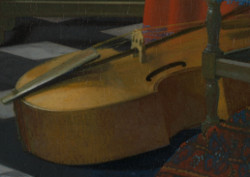
The viola da gamba holds a subtle yet symbolically significant presence in Vermeer's musically-themed paintings: The Music Lesson, The Woman with a Lute, The Concert and A Lady Seated at a Virginal. Notably, in each of these works, Vermeer never depicts the instrument in action. Instead, it rests, untouched and perhaps awaiting someone, likely a male figure, to bring it to life with music.
Historically, the viola da gamba, alongside the lute, stands as one of the most frequently illustrated instruments across various artistic mediums, from paintings to sculptures to miniatures. Its delicate yet distinct sound echoes the nuances of the human voice, harmonizing beautifully with the lute. The viol's deep resonance and commanding presence have traditionally been linked to masculine attributes, while the virginal often symbolizes the feminine.
The Oriental carpet
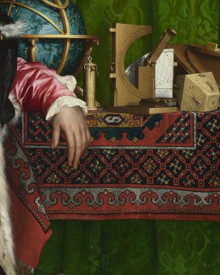
The Ambassadors (detail)
Hans Holbein the Younger
1533
Oil on wood, 207 x 209 cm.
National Gallery, London
By the 13th century, travelers and merchants, including the famed Marco Polo, had already noted the exquisite beauty of Oriental carpets during their expeditions. These carpets soon found their way to Venice and, subsequently, spread throughout Europe. Although actual specimens from these early times are scarce, their essence is immortalized in European paintings by renowned artists such as Giotto, Ghirlandaio, Holbein, Van Eyck, Lotto and Vermeer. These paintings often depicted intricate carpet designs originating from Turkey and Iran.
While many Dutch interior scenes from this period showcase these carpets, suggesting they were common household items, their sparse mentions in death inventories tell a different story. Furthermore, these "turkse" (Turkish) and "persiche tapijten" (Persian carpets) were rarely listed in significant numbers among the cargoes of Dutch merchant vessels. There's evidence to suggest that some painters provided their own carpets for these paintings, and intriguingly, a single carpet could be reused in artworks by successive generations of artists.
The cittern on the foreground table
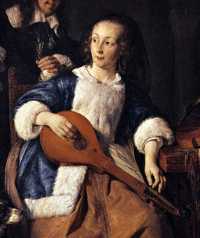
The Cittern Player (detail)
Gabriel Metsu
After 1660
Oil on oak, 37 x 30 cm.
Staatliche Museen, Kassel
To the casual observer, the instrument resting at an angle on the carpeted table might go unnoticed. However, it is a cittern—a stringed musical instrument from the Renaissance period, belonging to the guitar family. Distinguished by its flat back, the cittern was simpler and more economical to produce compared to the lute. Its design made it more user-friendly, easier to maintain in tune and given its robust nature, it was considerably more portable. The cittern became a popular choice for informal music sessions among commoners, akin to the modern-day guitar's role.
In artworks like The Concert, The Girl Interrupted in her Music and The Glass of Wine, the cittern is subtly placed on a table or chair. Yet, for those acquainted with its distinctive flat body, distinguishing it from the lute's pear-shaped structure isn't a challenge. Artists often depicted instruments from such angles to showcase their proficiency in foreshortening, a crucial technique to enhance the realism of objects within a spatial context.
The cittern found favor among both the average citizen and the elite during the Renaissance. Its straightforward tuning and ability to generate uncomplicated chords made it an ideal instrument for accompaniment, be it for vocals or dances.
The sound of a cittern is often described as bright, ringing and resonant, partly because of its metal strings. Compared to the soft, mellow tones of instruments like the lute or the wooden-stringed guitar, the cittern produces a more jangling and clear sound, somewhat similar to a modern mandolin or a 12-string guitar. The instrument's design allows for strong projection, making its tone distinct and easily audible. When played, the cittern often evokes a lively, folk-like quality, suitable for both melodic lines and rhythmic accompaniments. The metallic strings give it a shimmering timbre, which was especially favored for dance tunes and accompanying songs during the Renaissance and Baroque periods.
The tiled floor

Portrait of a Family Playing Music (detail)
Pieter de Hooch
1663
Oil on canvas, 124.5 x 142.5 cm.
Cleveland Museum of Art, Cleveland
Patterned marble floors are a recurring feature in many genre interiors from the mid to late 17th century, leading many to assume their prevalence in the homes of the well-to-do. However, Willemijn Fock, a historian of decorative arts, has shown that marble-tiled floors were exceptionally rare in the 17th-century Netherlands. Such opulent flooring was reserved for the houses of the elite and typically limited to specific areas like the voorhuis or corridors. Artists, perhaps drawn to the complex task of portraying the intricate perspective of multicolored marble tiles, might have amplified their presence in their works.
While The Concert is often seen as a counterpart to Vermeer's Music Lesson, the two paintings showcase distinct marble floor patterns. Notably, Vermeer consistently omitted the reflections one would expect from genuine polished tiles. This raises the possibility that Vermeer's varied tile patterns were creative liberties rather than faithful representations. Philip Steadman suggests that Vermeer initially painted the more commonplace ceramic tiles found in his own home, as seen in his earlier pieces, The Glass of Wine and Girl with a Wine Glass. Intriguingly, Steadman observed that the black and white marble tiles are exactly twice the size of their ceramic counterparts, which suggests that Vermeer might have adapted a simple diagonal grid from the ceramic tiles, transposing it onto his canvas and then modifying their patterns to achieve the most visually pleasing effect. Instead of a straightforward checkerboard arrangement, the design of the Concert's floor deviates with occasional substitution: a white tile is periodically replaced with a black one, creating a unique pattern where groups of five black tiles form a cross.
The three musicians
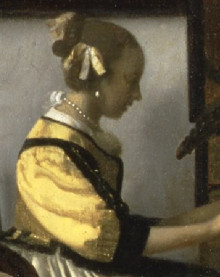
While there's no direct evidence linking Vermeer's composition of The Concert to another specific artwork, there's a vast array of portrayals of informally arranged musicians within the popular genre known as the "merry company." The harpsichordist, depicted in profile, sports a stylish silk jacket reminiscent of those seen in Vermeer's earlier works. Its striking lemon shade, whose intense coloring contrasts with the cool gray backdrop, was crafted using lead-tin yellow, a common pigment found on the palettes of many 17th-century artists. Her thoughtfully shaded profile conceals her privacy from prying eyes, further emphasizing the intimate ambiance of the musical gathering.
In the foreground, before the harpsichord, a man is seated with his back to the viewer, positioned on a chair distinguished by its vibrant orange-red backrest. From what's visible of his instrument, it appears to be a theorbo-lute, with only a portion of its neck and the dual pegboxes in sight. Adorning the man is a wide, decorative military sash from which hangs a sword. To the right of the harpsichord stands a singer, her gaze fixated on a music sheet she holds. Her other hand is raised, and while it's often speculated that she's keeping time, such a gesture might be unnecessary for such an intimate ensemble. It seems more likely that her gesture complements or underscores her vocal performance.
The seated gentleman

A Woman Playing the Theorbo-Lute and a Cavalier (detail)
Gerrit ter Borch
c. 1658
Oil on canvas, 36.8 x 32.4 cm.
Metropolitan Museum of Art,
New York
The seated man, discernible mostly by his involvement with the partially hidden theorbo-lute, is deeply engrossed in the musical ensemble with his companions. His sash and the sword at his side hint at his possible military affiliations, potentially linking him to the Delft Civic Guard.
A 1655 Delft decree described a Civic Guard member as originating from "the most suitable, most peaceful and best-qualified citizens or their offspring." The compensation they received was modest, often just a minor stipend or some tax exemptions. However, being a part of the Civic Guard was viewed as a significant civic distinction, essentially crafting a form of "civic aristocracy."
The charter of the militia was clear about the age and financial prerequisites for its members. The latter was essential given that members were expected to personally procure their entire kit, including weapons and uniform. Any disputes or resentment amongst members were strictly forbidden and could result in fines.
While the Civic Guard members took their oaths seriously, there were instances in Delft which revealed that they sometimes fell short of public expectations. Nevertheless, they were integral to the foundational structure of Delft.
In this depiction, as in many others from that period, the presence of the armed gentleman doesn't disrupt the tranquil and harmonious ambiance that permeates the scene.
The standing young musician

Unfortunately, the poised figure of the standing woman dressed in a bluish-green jacket has deteriorated since it left Vermeer's easel. The peculiar gray hue of her gown was originally a vibrant blue, but it has faded over time, revealing the dark gray underlayer. It's probable that Vermeer overlaid this with a delicate glaze of ultramarine blue. As a result, we can infer that the room was originally more vividly colored, mirroring the delicate yet harmonious notes of the trio's musical piece.
The singer's attention is directed at a musical score, likely containing both lyrics and notation. Walter Liedtke observed that her raised hand might not be marking time. Typically, small chamber ensembles wouldn't require a conductor to maintain rhythm. The setting's formality doesn't readily reveal if the musical piece is secular or sacred. Yet, considering the era's prevalent songbooks often featured love songs, the artworks in the background might hint, both subtly and overtly, at the romantic undertones of the tableau.
The seated harpsichordist
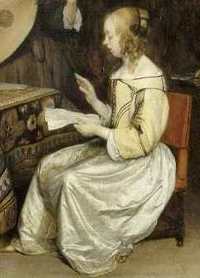
The Concert (detail)
Gerrit ter Borch
c. 1657
Oil on canvas, 47 x 44 cm.
Louvre, Paris
When Vermeer painted the silk gown of the seated musician, he likely knew it would be inevitably compared to those painted by his formidable competitor, Gerrit ter Borch from Deventer. Ter Borch, older than Vermeer and a pivotal figure in Dutch interior painting, had built his reputation predominantly on his extraordinary skill in depicting the silk garments of upper-class women. His renditions of silk are so convincing—even to contemporary art enthusiasts—that they seem almost alive.
The market demand for such intricate interior paintings was significant, and these lavish garments were a major attraction. Ter Borch and his assistants had developed a method to mechanically replicate the most admired versions of these silk dresses onto fresh canvases. Seven iterations of one particular dress still exist today.
While Vermeer didn't aim for the microscopic detail that characterized Ter Borch's realism, the silk gown in The Concert remains one of the most captivating passages in his body of work. Unlike Ter Borch, who meticulously captured every nuance of light on every fold and crease, Vermeer devised a subtly powerful play of light through mosaic-like paint patches that seamlessly combine to evoke the essence of silk and light.
In Vermeer's artworks, reality and imagination merge to suit the artist's vision. For instance, while window frames and walls are depicted realistically, the marble floor designs, in most instances, are imagined and realized through linear perspective. The movable props—like porcelain wine jugs, tables, paintings, mirrors and maps—likely belonged to Vermeer. However, the tapestries and keyboard instruments, both being rare and expensive, were probably rented for the occasion. It's also plausible that Vermeer painted his figures not from living models but from mannequins to ensure consistent lighting on the dress folds, which would be disrupted each time a live model repositioned.
Vermeer had channels through which he accessed these luxury items. His affluent Delft patron, Pieter van Ruijven and his wife Maia de Knuijt, is a likely source. Additionally, Vermeer's speculated association with Constantijn Huygens, a Dutch diplomat, poet and musician, might have introduced him to an exclusive circle of art connoisseurs willing to lend their prized instruments for the sake of art.
In some ways, Vermeer's painted settings resemble today's interior design magazine advertisements, meticulously assembled and lit solely for photography, then deconstructed afterward. Vermeer's immaculate compositions depict an interior ideal—brighter, tidier and more ornate. Furthermore, these paintings themselves were valuable assets, enhancing the cultural stature of those who owned them.
The draw-leaf table

* Hiding in the deep foreground shadows of some interiors by Vermeer is a sturdy draw-leaf table, called a balpoottafel or trektajel in Dutch. From its origin at the beginning of the 17th century, the draw-leaf table evolved from a solid everyday object into a richly ornamented veneered showpiece. It would have been extended for special occasions. One of the most characteristic features of the draw-leaf table is its bulbous spherical legs, which are most clearly visible in Vermeer's Art of Painting. Rather than waste an extremely thick piece of wood, the cabinet maker added wood blocks to all four sides of each leg before turning them. Thus, the leg was thickened only at the position of the ball. This process also reduced the chance of splitting the wood. The stretchers between the legs strengthen the table. In the first half of the 17th century, they formed a rectangle; in the second half of the century, the stretcher moved to the middle of the table with a V-shaped connection at the two ends, a so-called double-Y form. Since the tables in Vermeer's paintings consistently feature the stretchers of the later type, and they exhibit the classical ball-leg design with a double leaf and ebony decorations, it's plausible to believe he used his own table as a reference.
* the information on the Dutch draw-leaf table was drawn from Golden: Dutch and Flemish Masterworks from the Rose-Marie and Eijk van Otterloo Collection (2011)
The background wall
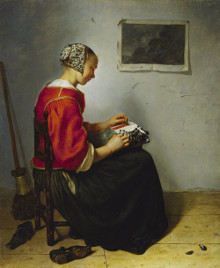
The Lace Maker
Caspar Netscher
1662
Oil on canvas, 33 x 27 cm.
The Wallace Collection, London
Since the Middle Ages, whitewashed walls have been ubiquitous in Dutch houses, castles and churches. Bare brick walls were reserved for industrial buildings or warehouses. However, these walls weren't simply brushed with whitewash; they were first coated with a thicker layer of putty made from seashells, limestone, or chalk. Walls could be whitewashed repeatedly to maintain their pristine appearance. In homes, whitewashed walls might be partially or entirely adorned with luxurious paneling or tapestries. Whitewashed walls served both practical and aesthetic purposes. Their pure white color reflected the available light in the often overcast Netherlands, enhancing the feeling of domestic comfort. Additionally, the putty and successive layers of wash concealed the bricks' unevenness, producing a smoother surface that accumulated less dust and dirt. These walls were also easier to clean. Moreover, whitewashing protected tapestries, maps and framed pictures from moisture damage. While background walls feature in many Dutch interior paintings, few artists, including Caspar Netscher, paid as much attention to this understated motif as Vermeer did, and even then, it was occasional.
The double shadows cast by the ebony-framed landscape on the background wall in The Concert suggest that two windows in the studio were open. To accurately depict the walls in domestic interior paintings, Dutch painters typically used a common recipe adopted for illustrating white objects ranging from glossy ceramics and delicate lace to billowing clouds: lead white, bone or ivory black and often an earth pigment, primarily the versatile raw umber. By adjusting the proportions of these three primary ingredients, a proficient painter could replicate, with unmatched realism, the effects of light, shadow, substance and surface texture on each unique type of white object. Black and white, due to their inherent neutrality, were the preferred choices for producing lighter shades of gray; umber was usually added to the deepest shadows, as dark gray mixtures appear unnaturally dark when solely combined with white and black.
Scientific studies have revealed that Vermeer used not just the traditional blend of white lead and black to generate the gray hues suitable for painting his background walls but also natural ultramarine, one of the most valuable pigments available to artists. The inclusion of small amounts of blue gave the gray paint a subtle blue tint, which more effectively conveyed the coolness of natural daylight. Vermeer might have adopted this method from other painters, like Gerard ter Borch, known for adding traces of blue to his gray concoctions when illustrating the luminous satin gowns for which he is celebrated.
special topics
- Vermeer's interiors: Fact or fiction?
- Singing & Songbooks in 17th-Century Netherlands
- Musical gatherings: Merry Companies
- Color in Vermeer's painting
- Musical instruments in Vermeer's painting
- Paintings in the Netherlands
- A very prestigious art collection
- A high-class bordello scene?
- The gentlemen's long hair
- Listen to period harpsichord music
Critical assessment
The change in mood is most evident in the benign treatment of the male figure. He is still a visitor in an interior that obviously favors feminine presence. The two landscapes function as the map does in The Soldier and the Smiling Girl, framing his head against an image of the outer world, while enclosing the seated woman even more rigorously within the space of the room. Yet now the structure of the painting conspires to absorb him, and render his intrusive aspect as inconspicuous as possible.
Edward A. Snow, A Study of Vermeer, 1979
The signature
No signature appears on this work.
(Click here to access a complete study of Vermeer's signatures.)
Dates
1664
Albert Blankert, Vermeer: 1632–1675, 1975
c. 1665–1666
Arthur K. Wheelock Jr., The Public and the Private in the Age of Vermeer, London, 2000
c. 1663–1666
Walter Liedtke, Vermeer: The Complete Paintings, New York, 2008
c. 1664–1665
Wayne Franits, Vermeer, 2015
c. 1662–1664
Pieter Roelofs & Gregor Weber, VERMEER, Amsterdam, 2023
(Click here to access a complete study of the dates of Vermeer's paintings).
The painting in its frame
(Click here to access all of Vermeer's paintings in their frames).
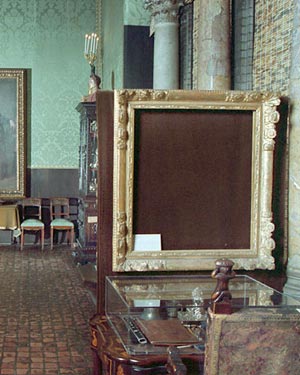 The Concert, which once hung in this frame, is one of the paintings stolen in the 1990 Isabella Stewart Gardner heist.
The Concert, which once hung in this frame, is one of the paintings stolen in the 1990 Isabella Stewart Gardner heist.
Provenance
- (?) Pieter Claesz. van Ruijven, Delft (d. 1674); (?) his widow, Maria de Knuijt, Delft (d. 1681); (?) their daughter, Magdalena van Ruijven, Delft (d. 1682);
- (?) her widower, Jacob Abrahamsz Dissius (d. 1695);
- Dissius sale, Amsterdam, 16 May, 1696, possibly no. 9;
- Johannes Lodewijk Strantwijk sale, Amsterdam, 10 May, 1780, no. 150 (to A. Delfos for the 'Heer van Vlaardingen', the following);
- Diederik van Leyden sale, Paris [Paillet], 5 November, 1804, no. 62 (to Paillet);
- Sale, London (Foster), 26 February, 1835, no. 127;
- Admiral Lysaght et al. sale, London [Christie's], 2 April, 1860, no. 49 (to Toothe);
- [Demidoff] sale, Paris, 1 April, 1869, no. 14, evidently to Thoré-Bürger;
- Thoré-Bürger (Etienne Joseph Théophile Thoré), Paris (?1869-d.1869);
- Thoré-Bürger sale, Paris, 5 December, 1892, no. 31 (to Robert for Gardner);
- Isabella Stewart Gardner, Boston (1869-d.1924);
- Isabella Stewart Gardner Museum, Boston (inv. P21W27).
Exhibitions
- Boston 5–28 March, 1897
One Hundred Masterpieces
Copely Hall, Copley Society
no. 98, as "The Muscians," lent by Mrs. John L. Gardner
(Click here to access a complete, sortable list of the exhibitions of Vermeer's paintings).
Vermeer's interiors: fact or fiction?
In Vermeer's paintings, we see a blend of fact and fiction tailored to the artist's needs. While the window casements and walls seem to have been factual, the marble floor patterns, in many instances, are fictitious, crafted with linear perspective and colored imaginatively. The movable props, such as porcelain wine jugs, tables, pictures, mirrors and maps, were likely Vermeer's possessions. In contrast, the tapestries and keyboard instruments, both rare and costly items, were probably borrowed for the purpose of the painting. It's also highly probable that Vermeer didn't paint his figures entirely from life but used a mannequin. This would ensure that the lighting on the folds of their dress remained consistent, undisturbed by a live model's movements. Additionally, the unpredictable Dutch weather would have challenged the painter's memory, as maintaining consistent lighting would have been a rarity.
Vermeer had access to luxury items through various means. His affluent Delft patron, Pieter van Ruijven and his wife Maria de Knuijt are is the most likely source. However, Vermeer's supposed association with Constantijn Huygens, the Dutch diplomat, poet and musician, could have facilitated connections with elite art enthusiasts who might have been willing to lend him their treasured instruments.
In some ways, Vermeer's painted scenes are reminiscent of contemporary interior design magazine advertisements. These settings are curated and illuminated for the sole purpose of photography, only to be dismantled later. Vermeer's flawless compositions depict an idealized interior — brighter, tidier and more lavishly adorned. Furthermore, these paintings were valuable assets, enhancing the cultural stature of those who owned them.
Musical gatherings: Merry Companies
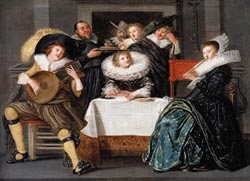
A Merry Company Making Music
Dirck Hals
1623
Oil on oak panel, 23 x 31 cm.
Private collection
In the 17th century, music was an integral part of Dutch life, spanning from the most modest to the most exalted tiers of society. Musical gatherings, such as the one depicted in The Concert, served not only as a comforting reprieve from life's inevitable challenges but also as an approved avenue for socializing, especially with members of the opposite sex, in an otherwise regulated setting. Many songbooks designed for domestic use focused exclusively on themes of love.
Merry Companies, as they came to be known, were a staple motif for pioneering Dutch artists such as Dirk Hals, Willem Pietersz. Buytewech, Anthonie Palamadesz. and Willem Cornelisz. Duyster. These artists captured the exploits of the reckless youth, wasting time on drink, romance, music and merriment, set against backdrops featuring neatly pressed linens and tables adorned with elegant goblets and dishes. Musical instruments were often prominently showcased. Some Merry Companies incorporated biblical parallels to imply that a virtuous life steers clear of the temptations of hedonism. These scenes also provided viewers with a vicarious experience of the lax morals of inns or brothels within a predominantly stringent society.
When Vermeer adapted the Merry Company motif, it had already been elevated to a remarkable standard by Gerrit ter Borch. Yet, only Vermeer possessed the ability to breathe into such a commonplace genre a unique blend of pictorial order and emotional depth.
Color in Vermeer's painting
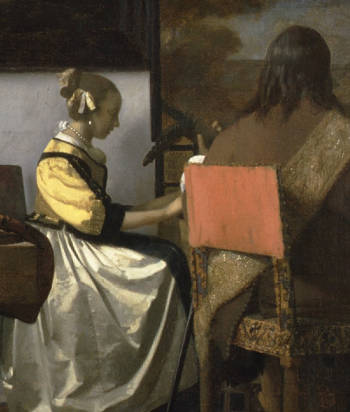
In the decades before Vermeer's emergence, even when somber hues dominated Dutch palettes, many painters found it hard to resist the allure of a bright color splash. Despite the limited availability of vibrant pigments, artists mastered the creation of a spectrum of lavish colors through layered techniques and astute color juxtaposition. Vermeer, on the other hand, primarily utilized the primary colors: blue, red and yellow. These vibrant hues are set against muted silvery grays and understated browns, granting them their distinctive resonance.

Vermeer's "working" palette
Vermeer's palette of vivid colors was narrower than that of many of his contemporaries in genre painting. He only incorporated orange and purple predominantly in his early history paintings. The sporadic bursts of vibrant green in his oeuvre typically play supporting roles and are often crafted from blends of yellow and blue pigments. Although verdigris, the most brilliant of all green pigments cherished by early Flemish painters, is present in his work, he used it sparingly.
Leafing through a Vermeer catalog, one can observe that nearly every central figure's attire is rendered in red, blue, or yellow. Only one significant figure, the writing mistress in Lady Writing a Letter with her Maid, is depicted in a subdued green. All the characters dressed in red were painted earlier in his career. Secondary characters are typically portrayed in muted or tertiary colors like olive green, dull brown, or black. By painting primary figures in vivid, affirmative colors, Vermeer guides the viewer's gaze, enhancing the narrative clarity of each piece.
The musical instruments in Vermeer's painting
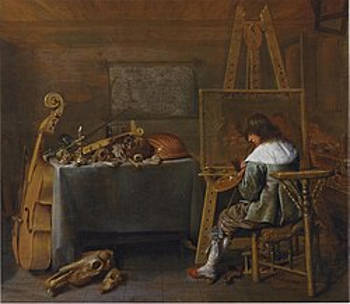
The Painter in his Studio
Hendrick Pot
c. 1650
Oil on wood, 42 x 48 cm.
Gemeentemuseum, The Hague
In fourteen out of the thirty-seven known Vermeer paintings, a diverse array of musical instruments are depicted, even if they're not always prominently showcased. Their recurring presence indicates they were of notable importance to the artist.
Within Vermeer's body of work, we encounter four muselar virginals, one harpsichord, three bass viols, five citterns, two lutes, a guitar, a trumpet and a recorder. In eight or nine of these compositions, the central theme revolves around music-making. While it's unclear whether Vermeer personally owned any musical instruments, his grandfather was indeed a musician. Vermeer's grandmother, Cornelia (Neeltge) Goris, after the passing of her first husband, married Claes Corstiaensz van der Minne in the same year. Claes, a tavern owner and professional musician residing in De Drie Hamers in Beestenmarkt, possessed a lute, trombone, shawm, two violins and a "cornet." However, the inventory of movable goods from the painter's home didn't list any musical instruments. It's plausible that Vermeer's aristocratic mother-in-law, Maria Thins, owned at least one instrument, perhaps a lute. Furthermore, it's likely that Vermeer observed more luxurious instruments at the residence of his affluent patron, Pieter van Ruijven. Among van Ruijven's possessions were a viola da gamba, violin, two flutes and various music books.
Vermeer might have also been acquainted with the instruments through Cornelis Graswinckel, a prosperous Delft brewer, who had a significant collection of music books, some of which were editions for keyboard instruments and tablatures for flutes. Additionally, some historians posit Vermeer's connection with Constantijn Huygens, a prominent figure in Dutch 17th-century culture who was an accomplished musician, composer and art enthusiast. If Vermeer did have ties with him, it's conceivable he would have visited the nearby Hague to admire Huygens' impressive collection of musical instruments.
As for the accuracy of Vermeer's depictions of these instruments?
Early music specialist, Louis Peter Grijp, remarks that while the instruments in Vermeer's artworks "are accurate, they could be more so." Albert Pomme de Mirimonde, in his work "Les Sujets musicaux chez Vermeer de Delft," pointed out that the musical notes on the sheet of paper in Love Letter don't align musically. Furthermore, the design of the flute in Girl with a Flute seems slightly off, which, along with other discrepancies in the painting, has led many experts to question its authenticity. Overall, while the musical instruments in Vermeer's paintings align with his broader artistic style, they don't necessarily reflect a profound understanding of music or the instruments themselves.
Paintings in the Netherlands

Collector's Gallery
Frans Francken the Younger
Oil on panel, 115.5 x 148 cm.
Schönborn-Buchheim Collection,
Leichtenstein Museum, Liechtenstein
In the 17th century, the United Provinces may have produced more paintings than any other country. Between 1600 and 1700, it is estimated that an astounding 5 million paintings were created in both small and large painting centers. This remarkable number becomes even more astonishing considering Calvinism's aversion to sacred images. Waves of iconoclasm had eradicated countless works of art. Today, the expansive churches in Dutch cities greet worshipers with stark, whitewashed walls. While inscriptions and coats of arms may adorn memorial tablets and occasional images embellish gallery balustrades, the interiors remain largely devoid of imagery.
However, Dutch homes were adorned with paintings, and over time, these homes themselves became subjects in numerous domestic interior scenes. It wasn't rare for a Dutch individual to possess ten or fifteen paintings, along with prints and expansive maps. In the residences of the affluent, as many as 50 paintings were typical. The generally compact size of Dutch paintings made them marketable and contributed to their widespread distribution. While rural laborers and peasants might not have been able to afford paintings, it is believed that even modest households often housed drawings and prints. The prices of these artworks varied greatly. While numerous paintings sold for less than 20 guilders, a grand portrait by Rembrandt might fetch 500 guilders, and a small depiction of daily life by the Leiden master, Gerrit Dou, could cost as much as 1,000 guilders—enough to purchase a commodious residence.
A very prestigious art collection

Photograph of Thoré-Bürger from
the sales catalogue of the
Thoré-Bürger collection, 1892
Thoré-Bürger, recognized as the rediscoverer of Vermeer, published under the pseudonym Wilhelm Burger. A passionate admirer of Dutch 17th-century art, Thoré penned a significant essay on Vermeer's work in 1866. While this essay became highly influential, it also introduced certain misconceptions regarding Vermeer's oeuvre. Thoré credited Vermeer with 66 paintings, though today only 35 or 36 are definitively attributed to the artist. Thoré also stimulated the revival of interest in Dutch painting and must be regarded as highly influential in the art of his era. Courbet closely modeled his depictions of everyday life in mid-nineteenth-century France on 17th-century Dutch examples. Degas himself is quoted as saying that he had found his painting style on the "route de Hollande," indicating a direct influence of Dutch painting on his work.
Bürger lacked the financial resources to acquire paintings on the same scale as some of the major European collectors with whom he was familiar. However, fueled by his rigorous research and keen pursuit of Related artworks, his collection grew to be more than just an "unusual gallery of bric-à-brac."In 1866, Thoré-Bürger's dedication culminated in a series of essays that extolled Vermeer's genius. Within these writings, he confidently cataloged 66 works as Vermeer's creations.
Beyond his writings, Thoré-Bürger's profound appreciation for Vermeer shone through in his personal art collection. Even without significant financial resources, he managed to acquire several of Vermeer's masterpieces, including Woman with a Pearl Necklace, The Concert, Lady Standing at a Virginal and Woman with a Pearl Necklace.
Listen to period music
![]() Prelude 1 [1.39 MB]
Prelude 1 [1.39 MB]
François Couperin
from L'Art de Toucher de Clavecin,
performed by Hendrik Broekman
on a Flemish single harpsichord.
http://www.hubharp.com/sound_samples.htm
![]() Come, Charming Sleep
Come, Charming Sleep
John Johnson
performed by members of Musica Antiqua,
Iowa State University.
http://www.music.iastate.edu/antiqua/

Harpsichord by Andreas Ruckers
1643
National Music Museum
Vermillion, South Dakota
The Harpsichord
Like the virginal, the harpsichord is likely derived from the medieval psaltery with a keyboard applied to enable the performance of polyphonic music—melody with accompanying chords.
The earliest known reference to a harpsichord dates back to 1397, mentioning that a certain Hermann Poll claimed to have invented an instrument called clavicembalum. The earliest known representation is found in a sculpture on an altarpiece from 1425 in Minden, located in North-West Germany.
The main centers for harpsichord production were situated in Germany, Flanders (primarily Antwerp, with the renowned families Ruckers and Couchet) and Italy.
The harpsichord reached its zenith in the 16th and 17th centuries but continued to be used throughout the 18th century for solo keyboard music (especially by composers like Bach, Couperin and Froberger), as well as an indispensable participant in chamber music, orchestral compositions and opera (accompanying the recitativo).
The harpsichord is characterized by its elongated wing shape, reminiscent of a grand piano. This shape arises from the fact that the strings, progressively growing longer from treble to bass, extend directly away from the player. At the heart of the harpsichord's mechanism lies the jack—a slender slip of wood that rests on the rear of the key. At the top of the jack, there is a plectrum that plucks the strings upon depression of the key. Each key corresponds to two strings, known as courses, which are tuned either to the same pitch or in octaves. A padded bar positioned overhead—the jackrail—prevents the jack from dislodging from the instrument when the key is struck.
While two manuals were common, the upper manual was initially used for transposition. Only in the latter half of the 17th century was the additional manual utilized to create tonal contrast, with the ability to couple the registers of both manuals to produce a fuller sound.
A high-class bordello scene?
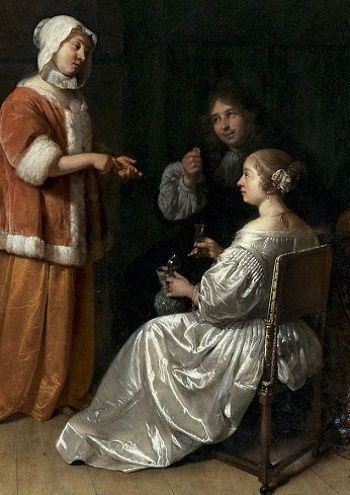
The Seduction (detail)
Caspar Netscher
1664
Oil on panel, 38 x 32 cm.
Private collection
After the brothel scenes of the Utrecht school fell out of popular favor, the theme was skillfully repurposed into a new style of sophisticated genre interiors. Earlier writers on Vermeer, guided by the explicit bordello scene painted by Dirck van Baburen, framed in a heavy black frame on the right, suggested that Vermeer might have depicted, in The Concert, a high-class yet thinly veiled brothel with a moralizing intention, akin to a form of Christian sermon. Recent scholarly analysis has challenged the idea that prosperous Dutch society required artistic reminders of moral values. Instead, it's proposed that Van Baburen's work was meant to contrast the pure, musical gathering. Still, it's plausible that Vermeer intended to subtly blend hints of both vice and virtue.
In Caspar Netscher's work, created during roughly the same period as Vermeer's Concert, the elegant young woman standing on the left assumes the role of a procuress. She pointedly extends her hand, demanding payment from the young man seated before her (a gesture also observed in Van Baburen's work). In response, the "gentleman" dutifully presents a gold coin as payment. The second young woman, dressed in a luxurious satin gown, stands ready with a pitcher and glass, poised to initiate the festivities as soon as the transaction concludes.
The man's long hair
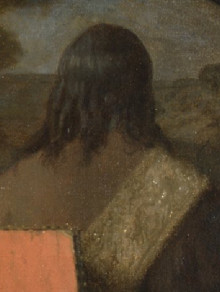
In spite of their appearance rooted in days gone by, Vermeer's depictions actually capture a world undergoing rapid shifts in moral standards and trends. Certain paintings of his can even be dated based on the hairstyles of the women depicted. Before the 1620s, men and boys were often portrayed with short hair. Yet, as early as the 1640s, the trend of sporting long hair had become unstoppable. Youths, students, university scholars, the urban elite and even ministers—especially the younger ones—all embraced the growing of their hair. Godefridus Cornelis Udemans, among the most influential theologians of his era, advocated for maintaining cropped hair as he believed that longer hair posed a threat to masculinity. He viewed young men with lengthy hair as effeminate and put forth a straightforward argument: when young men adopted long locks, they not only bore a physical resemblance to women, but also mimicked their behaviors. Consequently, vanity took root and men spent endless hours preening before mirrors. Following the 1670s, long hair on men became the prevailing fashion, even among young ministers. All male figures in Vermeer's works are depicted with long hair.
from: Benjamin B. Roberts, Sex and Drugs before Rock 'n Roll: Youth Culture and Masculinity during Holland's Golden Age (Amsterdam: Amsterdam University Press, 2012)
Singing & songbooks in 17th-century Netherlands
drawn from: Zingend door het leven: Het Nederlandse liedboek in de Gouden Eeuw, Natascha Veldhorst, Amsterdam University Press, 2009.
Although many songbooks have also been published after the 17th century in the Netherlands, the songbook production of the Golden Age remains the most surprising: it was the first flourishing period of the songbook after its inception in the 16th century, in which songwriters and publishers brought hundreds of beautiful, stylish, funny, and touching editions to the market with overwhelming energy and determination. "In the 17th century, it rains songbooks," noted literary historian Gerrit Kalff already in 1884.
Songbooks contained simple songs on all sorts of topics and could be used by people who didn't need to have musical training. There were special songbooks for lovers, anthologies for older people who liked to sing traditional songs, collections for various religious groups, local booklets for the residents of a city or village and also songbooks for children, such as the anonymous Kinder-liedekens ofte jeughds-boecxken (1630).
The songbook from the Golden Age also served as a cheerful social binder, as a virtuous educator, and moreover, as a melancholy fighter for saddened souls. From its inception in the first half of the 16th century, both secular and spiritual songbooks advertised their beneficial effects on human sentiment on title pages and prefaces. The Antwerp Songbook (1544) promoted itself as "A beautiful song book in which you will find various songs, old and new, to drive away sorrow and melancholy." More than a century later, the Amsterdamsche vreughde-stroom (1654) also aimed to serve the "sweet Amsteldam maidens," to whom the book was dedicated, "in these long evenings to dispel the tediousness of them."
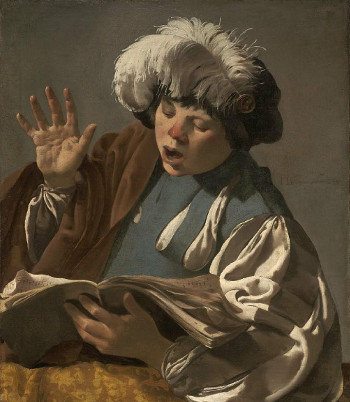
Singing Boy
Hendrick ter Brugghen
1627
Oil on canvas, 85 x 74 cm.
Museum of Fine Arts, Boston
Thus, the songbook functioned as a portable pharmacy for the spirit: easy to carry in the pocket, usable alone or in company, and filled with musical remedies for various patients. Songs about heartbreak, for example, that could soothe one's own misery— as Tesselschade Roemer Visscher so aptly put it: "pain in rhythm cannot be so intense." Or songs to ward off fears, like the Liedeken van Benauthe that Eduard de Dene wrote for his son, so he could sing courage into himself when it was dark outside: "Sometimes through the clouds the moon shines, a little song resonates so well behind the streets." Moreover, there were all kinds of songs that could serve as a strong antidote to the evil to which humans are naturally inclined. It's an idea we also find with the German Protestant theologian Martin Luther: God exists, the devil exists, and music has the power to honor the good of the former and combat the evil of the latter.
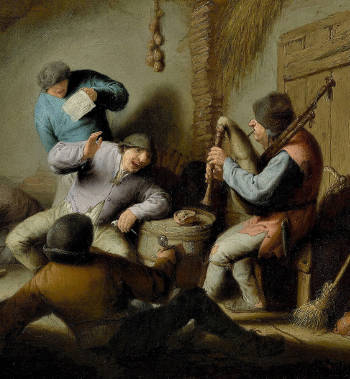
Barn Interior with Peasants making Music (detail)
Adriaen van Ostade
-
Oil on panel, 39 x 33 cm.
Private collection
It's known that music has traditionally been used to cure depression and attain inner peace. This idea was by no means new in the 17th century. However, what's remarkable about this period is the incredibly literal and practical interpretation of this age-old belief. For instance, the songbook author Claes Jacobsz Wits was described by a fellow poet in a laudatory poem as a "spiritual soul doctor".The Catholic Joannes Stalpart van der Wiele titled one of his songbooks Extractum katholicum (1631), and adorned it with a programmatic title page featuring an engraving of a richly decorated apothecary jar. This ornate apothecary jar was also used in Dutch emblematics to illustrate the adage "Meliora latent" (better things are hidden) on the first title engraving of Jacob Cats' Sinne- en minnebeelden (1618).
Defining the 17th-century Dutch song culture were primarily the poets, who chose the music to which they wanted to set their poems. These were existing melodies that they themselves had discovered domestically or abroad, or familiar tunes they adopted from their writing peers and admired predecessors. Consulting with a composer wasn't necessary in such cases. Only towards the end of the century did it become more common for poets and composers to collaborate. Before that period, such collaboration remained a rarity.
Generally, songbooks utilized existing music. This music could come from virtually anywhere: from their own national song tradition or from any surrounding European countries. The melodies could be old or new, simple or intricate, sad or joyful. Some were so popular that they were used repeatedly. These melodies were passed down throughout the century like relay batons – a fascinating process that is clearly evident from the content of the extant songbooks. The music was kept alive by the many new lyrics set to the same persistent melodies, and these lyrics were partly influenced by the content of the music itself.

